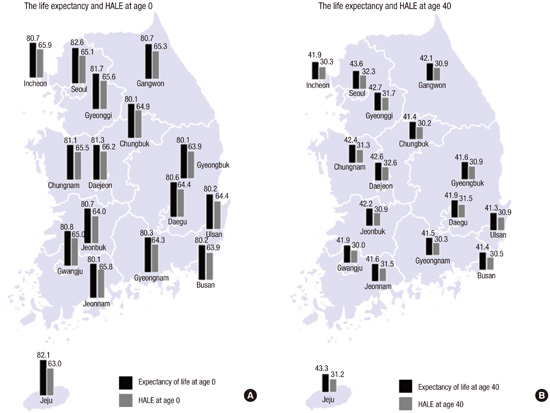2. Field MJ, Gold MR. Summarizing Population Health: Directions for the Development and Application of Population Metrics. Washington, D.C.: National Academy Press;1998.
3. Murray CJ, Salomon JA, Mathers CD, Lopez AD. Summary Measures of Population Health: Concepts, Ethics, Measurement and Applications. Geneva: World Health Organization;2002.
4. Sullivan DF. A single index of mortality and morbidity. HSMHA Health Rep. 1971; 86:347–354.
5. Salomon JA, Wang H, Freeman MK, Vos T, Flaxman AD, Lopez AD, Murray CJ. Healthy life expectancy for 187 countries, 1990-2010: a systematic analysis for the global burden disease study 2010. Lancet. 2012; 380:2144–2162.
6. Gold MR, Stevenson D, Fryback DG. HALYS and QALYS and DALYS, Oh My: similarities and differences in summary measures of population health. Annu Rev Public Health. 2002; 23:115–134.
7. Hyder AA, Puvanachandra P, Morrow RH. Measuring the health of populations: explaining composite indicators. J Public Health Res. 2012; 1:222–228.
8. Mathers CD, Vos T, Lopez AD, Salomon J, Ezzati M. National Burden of Disease Studies: a Practical Guide (Edition 2.0. Global Program on Evidence for Health Policy). Geneva: World Health Organization;2001.
9. Crimmins EM, Saito Y. Trends in healthy life expectancy in the United States, 1970-1990: gender, racial, and educational differences. Soc Sci Med. 2001; 52:1629–1641.
10. Brønnum-Hansen H. Health expectancy in Denmark, 1987-2000. Eur J Public Health. 2005; 15:20–25.
11. Nepomuceno MR, Turra CM. Trends in healthy life expectancy among older Brazilian women between 1998 and 2008. Rev Saude Publica. 2015; 49:1–8.
12. Banham D, Woollacott T, Lynch J. Healthy life gains in South Australia 1999-2008: analysis of a local burden of disease series. Popul Health Metr. 2011; 9:13.
13. Doblhammer G, Kytir J. Compression or expansion of morbidity? Trends in healthy-life expectancy in the elderly Austrian population between 1978 and 1998. Soc Sci Med. 2001; 52:385–391.
14. Lau RS, Johnson S, Kamalanabhan TJ. Healthy life expectancy in the context of population health and ageing in India. Asia Pac J Public Health. 2012; 24:195–207.
15. Gu D, Dupre ME, Warner DF, Zeng Y. Changing health status and health expectancies among older adults in China: gender differences from 1992 to 2002. Soc Sci Med. 2009; 68:2170–2179.
16. Chiang CL. The Life Table and Its Applications. Malabar, FL: Robert E. Krieger Publishers;1984.
17. Kweon S, Kim Y, Jang MJ, Kim Y, Kim K, Choi S, Chun C, Khang YH, Oh K. Data resource profile: the Korea National Health and Nutrition Examination Survey (KNHANES). Int J Epidemiol. 2014; 43:69–77.
18. Ock M, Lee JY, Oh IH, Park H, Yoon SJ, Jo MW. Disability Weights Measurement for 228 Causes of Disease in the Korean Burden of Disease Study 2012. J Korean Med Sci. 2016; 31:Suppl 2. S129–S138.
19. Vos T, Flaxman AD, Naghavi M, Lozano R, Michaud C, Ezzati M, Shibuya K, Salomon JA, Abdalla S, Aboyans V, et al. Years lived with disability (YLDs) for 1160 sequelae of 289 diseases and injuries 1990-2010: a systematic analysis for the global burden of disease study 2010. Lancet. 2012; 380:2163–2196.
20. Stiefel MC, Perla RJ, Zell BL. A healthy bottom line: healthy life expectancy as an outcome measure for health improvement efforts. Milbank Q. 2010; 88:30–53.
21. Fouweather T, Gillies C, Wohland P, Van Oyen H, Nusselder W, Robine JM, Cambois E, Jagger C. JA: EHLEIS Team. Comparison of socio-economic indicators explaining inequalities in healthy life years at age 50 in Europe: 2005 and 2010. Eur J Public Health. 2015; 25:978–983.
22. Lagiewka K. European innovation partnership on active and healthy ageing: triggers of setting the headline target of 2 additional healthy life years at birth at EU average by 2020. Arch Public Health. 2012; 70:23.
24. Steensma C, Loukine L, Orpana H, Lo E, Choi B, Waters C, Martel S. Comparing life expectancy and health-adjusted life expectancy by body mass index category in adult Canadians: a descriptive study. Popul Health Metr. 2013; 11:21.
25. Bebbington A, Bajekal M. Sub-national variations in health expectancy. In : Robine JM, Jagger C, Mathers CD, Crimmins EM, Suzman RM, editors. Determining Health Expectancies. Chichester: Wiley;2003. p. 127–147.
26. Manuel DG, Goel V, Williams JI, Corey P. Health-adjusted life expectancy at the local level in Ontario. Chronic Dis Can. 2000; 21:73–80.
27. Smith M, Edgar G, Groom G; Office for National Statistics. Health expectancies in the United Kingdom, 2004-06. Health Stat Q. 2008; 40:77–80.
28. Ock M, Han JW, Lee JY, Kim SH, Jo MW. Estimating quality-adjusted life-year loss due to noncommunicable diseases in Korean adults through to the year 2040. Value Health. 2015; 18:61–66.
29. Lee J, Lee WY, Noh M, Khang YH. Does a geographical context of deprivation affect differences in injury mortality? A multilevel analysis in South Korean adults residing in metropolitan cities. J Epidemiol Community Health. 2014; 68:457–465.








 PDF
PDF Citation
Citation Print
Print





 XML Download
XML Download